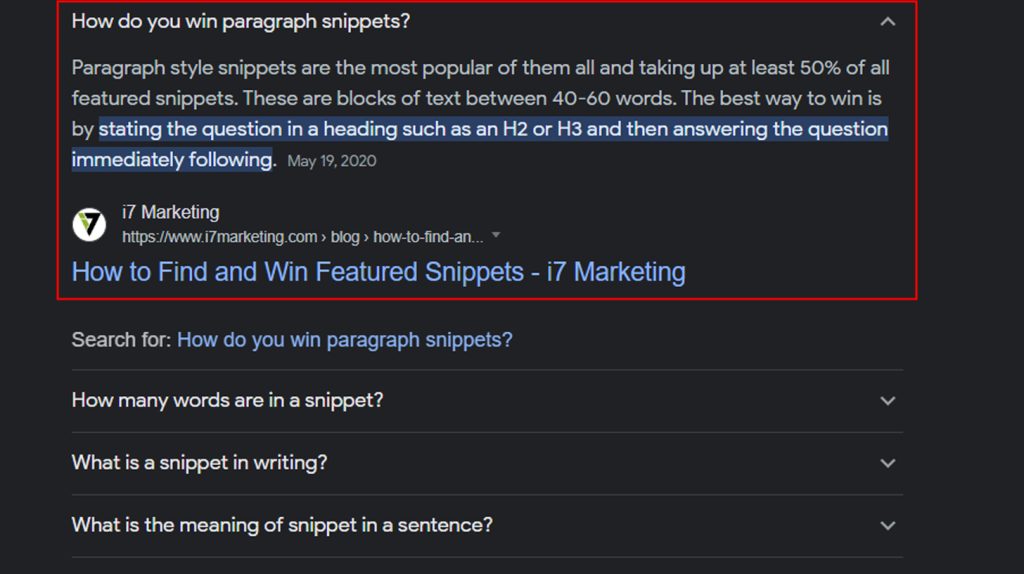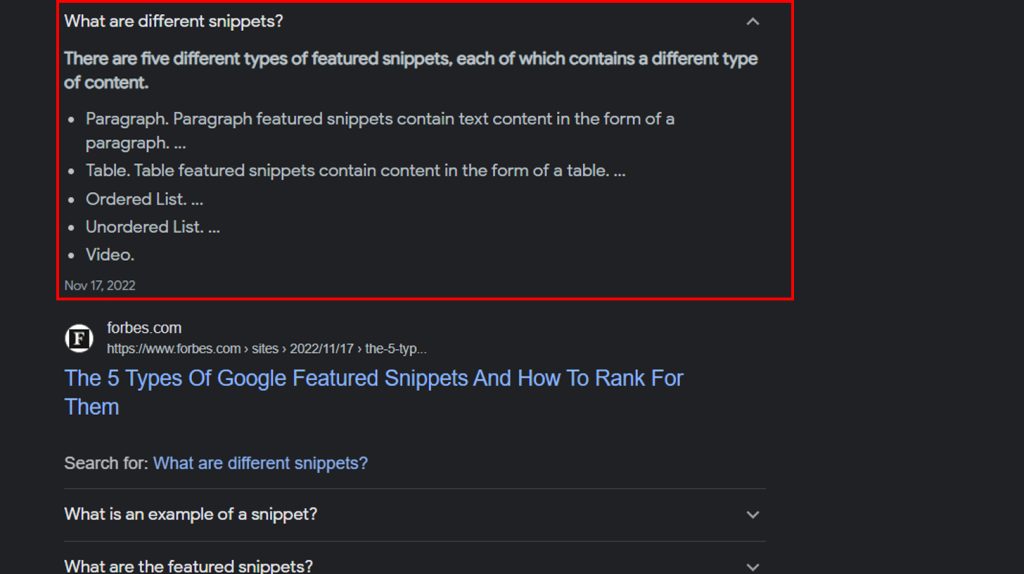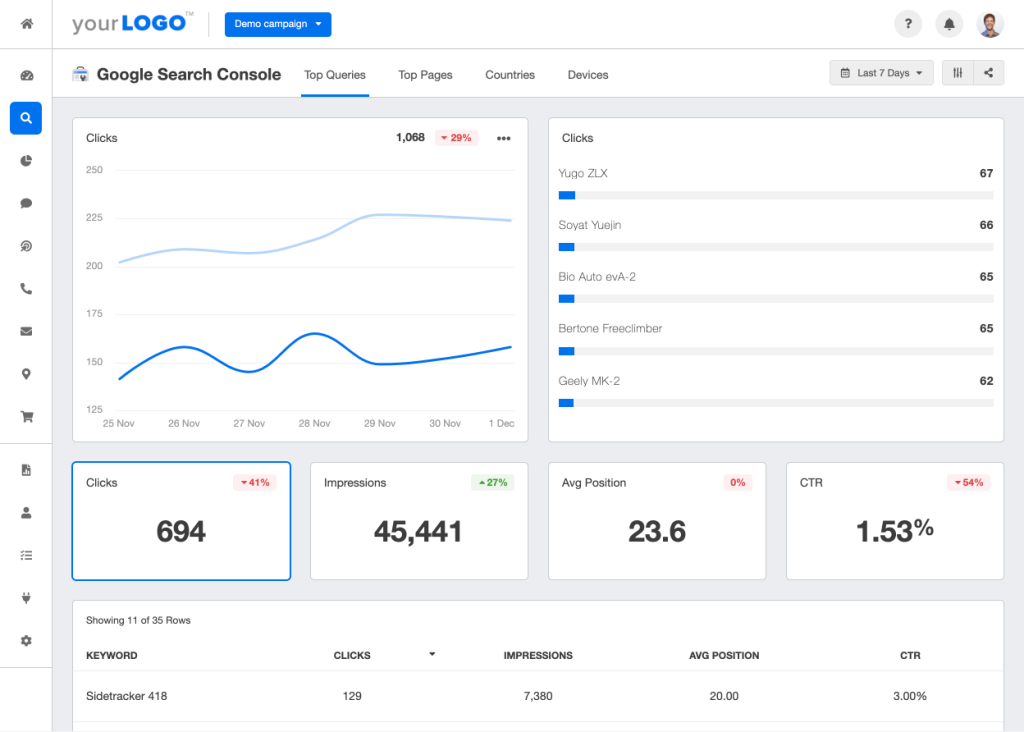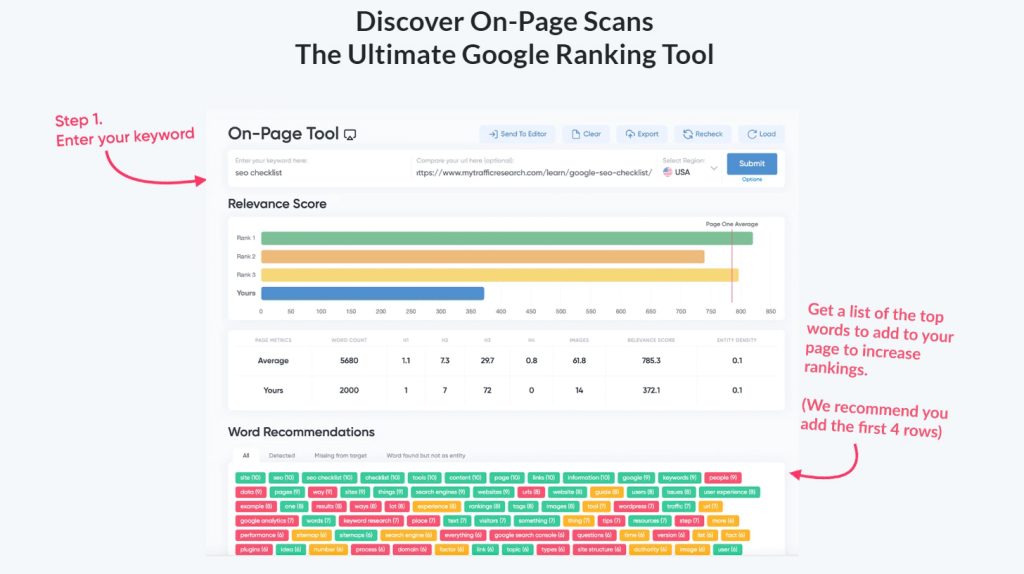How to Optimize Your Content for Featured Snippets: A Step-by-Step Guide
Picture this: Your website is ranking on the first page of Google, but you’re still looking for that extra edge to outshine your competitors. The answer lies in the coveted “position zero” – featuring in Google’s Featured Snippets. Follow our step-by-step guide on optimizing content for Featured Snippets and watch as your website vaults over the competition, empowering users with seamless information access – and bringing you more clicks than ever before. Don’t believe us? Keep reading with On-Page and experience the transformation.

To optimize your content for featured snippets, start by conducting keyword research and analyzing competitor’s featured snippet content. Next, structure your content to answer common questions and format it in a way that is easy for Google to display as a featured snippet. Additionally, including visually appealing elements such as images or charts can help increase the chances of being featured. Finally, prioritize creating high-quality, informative content that meets searcher intent and communicates clear value to the user.
Understanding Featured Snippets
Featured snippets are powerful tools that can dramatically increase your website’s visibility on Google search results. Essentially, featured snippets are special answers to common questions displayed prominently at the top or near the top of the search results page. These snippets provide users with a quick and simple answer to their query, making them ideal for voice searches and mobile searches where convenience is key.

For instance, let’s say you search for “how long does it take to cook pasta?” on Google. The first thing you’ll see is a special box at the top of the results page that shows a brief summary of the cooking time for different types of pasta, along with a link to the website where that information was pulled from. This is an example of a featured snippet in action.
Studies have shown that being featured in a snippet can dramatically boost your website’s traffic and click-through rates. In fact, pages with featured snippets see an average of 30% increase in traffic! That’s because when your content appears in a featured snippet, it essentially jumps to position #0 on the search engine results page (SERP), above even the #1 ranked result. As such, optimizing your content for featured snippets should be a top priority for anyone looking to rank higher on Google.
However, there is some debate among SEO experts as to whether or not featured snippets actually help or hurt organic traffic. Some argue that gaining a feature snippet means losing clicks, as users may find all the information they need without having to click through to your site. While this may be true in some cases, most studies show that featuring in snippets increases click-through rates rather than decreasing them.
Now that we have a better understanding of what featured snippets are and why they’re important, let’s dive into the different types of featured snippets you can target.
Types of Featured Snippets
There are four main types of featured snippets, each with their own unique attributes and benefits. These include paragraph snippets, list snippets, table snippets, and video snippets. The majority of featured snippets are paragraph snippets, accounting for roughly 82% of all featured snippets.
Paragraph snippets
Paragraph snippets are essentially brief summaries or answers to a specific question related to the search query. They’re concise and to-the-point, providing users with a quick and easy answer to their question without having to sift through multiple pages of information. For instance, if you search for “how to bake a cake,” you might see a paragraph snippet that provides step-by-step instructions for baking a cake.

Think of paragraph snippets as bite-sized pieces of information – easily digestible chunks of content that are perfect for mobile searches and voice queries.
List snippets
List snippets are exactly what they sound like – lists of items related to the search query. These can be either numbered lists (like “10 best movies on Netflix”) or bulleted lists (like “most popular baby names”). List snippets are ideal for searches where users want a quick overview or comparison of different items.

Table snippets
Table snippets are less common than other types but can be incredibly useful when it comes to displaying data-driven information or comparisons. If your website features any kind of chart or table-related information, it’s definitely worth optimizing that content for table snippets.

Video snippets
When it comes to video snippets, there is some debate among SEO experts about whether or not they’re actually effective. While video content can certainly help boost engagement and time-on-page metrics outside of Google search results, not all videos translate well into feature snippets. Moreover, including videos in your page may slow down its load times which too slow page loads hurt rankings.

Now that we’ve gone over the different types of featured snippets you can target, let’s talk about how to optimize your content for these valuable search features.
- In order to optimize your content for featured snippets, it’s important to understand the different types available, which include paragraph snippets, list snippets, table snippets, and video snippets. Paragraph snippets are the most commonly used and provide a concise answer to a specific query. List snippets are ideal for comparisons of items while table snippets can be useful for displaying data-driven information. While video snippets may not always be effective, optimizing your content for them can still boost engagement and time-on-page metrics outside of Google search results. Understanding each type of featured snippet can help you tailor your content to better meet the needs of users and increase your chances of being featured in a coveted spot on the search engine results page.
Benefits of Featured Snippets
Understanding the benefits of featured snippets is crucial for anyone looking to optimize their content for these highly desirable placements in search engine results pages (SERPs). The primary benefit of appearing in a featured snippet is increased visibility and web traffic. When a searcher types in a question, seeing your content appear at the very top of the page in an expanded, descriptive box can be incredibly compelling. In fact, being at position #0 above organic rankings has been shown to increase click-through rates (CTR) and organic traffic by up to 677%.
For example, let’s say you operate a travel blog and someone types in “best beaches in Hawaii” – wouldn’t it be great if your website appeared as the first result with a featured snippet detailing the top 5 beaches? Not only would this give users immediate access to your expert knowledge, but it could potentially drive thousands of visitors to your site.
Furthermore, pages with featured snippets see an average of 30% increase in traffic and nearly 99% of featured snippets come from websites that mostly rank on the first page of search results. This means that not only do featured snippets benefit those who already have a strong ranking online, but they can also increase your chances of getting onto that coveted first page.
Think of it this way: appearing in a featured snippet is like having prime real estate on Google’s front page. Just like how brick-and-mortar stores aim to snag the best retail locations, featuring at #0 or within feature snippets can mean more foot traffic and ultimately more revenue.
Keyword Research and Competitor Analysis

Now that we’ve covered some of the many benefits of appearing in a featured snippet or position #0, it’s time to dive into how you get there. To begin optimizing your content for these spots, you’ll first need to conduct extensive keyword research and competitive analysis.
Say you wanted to target the keyphrase “how to make homemade pasta”. One way to start your research would be to type this exact phrase into Google and see if a featured snippet appears. If it does, take note of what that snippet includes – is it a paragraph, a list, or something else? Knowing this information can help guide your content formatting.
Of course, some marketers worry that featuring in a snippet can actually lead to decreased click-through rates because users may find the answer they’re looking for without having to click through to their website. However, studies have shown that this concern is largely unfounded – in fact, appearing in featured snippets often leads to increased click-through rates.
Additionally, by conducting keyword research and analyzing competitors using tools like Ahrefs or SEMrush, you can find gaps in your content that could potentially lead to more opportunities for featured snippets. Keep track of topics your competitors are covering that you aren’t – including specific questions and phrases they’ve optimized for – as well as the types of featured snippets they have secured.

It’s helpful to think of your keyword research as casting out a wide net: the more expansive and specific the keywords you target, the likelier you are to reel in valuable traffic. Similarly, understanding your competitors’ strategies can help ensure that you don’t get left behind in the ongoing race for front-page real estate.
Tools for Research and Analysis
When it comes to optimizing your content for featured snippets, conducting thorough research and analysis is crucial. Fortunately, there are numerous tools available in the market that can help you with this task.
One such tool is Ahrefs. With its Site Explorer feature, you can analyze any website’s backlinks profile, organic search traffic, and keywords ranking data. This information can then be used to identify competitors’ featured snippets and gather the keywords for each featured snippet-owned content.

Another powerful tool is SEMrush. Its comprehensive keyword research and competitive analysis features allow you to identify the most relevant keywords for your content and uncover competitors’ strategies for targeting featured snippets. Additionally, SEMrush has a Featured Snippets report that shows the exact phrases your competitors target in their Featured Snippets.
If you’re looking for a free tool, then Google Search Console might be your best bet. It provides valuable insights into your website’s ranking on Google, including impressions, clicks, and average position in search results. You can use this data to identify queries that trigger your site’s appearance in a featured snippet.

Other helpful tools include Moz Pro, Serpstat, and Keyword Tool. These platforms offer various features such as competitor analysis, keyword research, topic research, and rank tracking that can assist you in optimizing your content for featured snippets.

It’s important to note that while these tools are incredibly useful, they shouldn’t be solely relied upon for research and analysis. Conducting manual research by reviewing competitors’ content and studying featured snippets within Google search results should also be part of your strategy. Combining both methods will give you a more holistic view of the competitive landscape and ensure that you’re not missing out on anything.
On-Page SEO Optimization for Snippets

Once you’ve conducted thorough research and analysis using the appropriate tools, it’s time to focus on optimizing your content for featured snippets through on-page SEO techniques.
One of the most important things to keep in mind when optimizing for featured snippets is that Google is looking for content that provides the best answer to a user’s query. As such, it’s critical to ensure that your content is well-structured, easy to read and includes relevant information. Additionally, the following techniques can be helpful in optimizing your content for featured snippets.
Think of your content as a movie trailer: you want to give users a taste of what they’re about to get without revealing everything. Ideally, you should aim to provide concise and clear answers that fulfill users’ queries while also encouraging them to click through to read more.
One technique is using descriptive headings and subheadings that accurately convey the main idea of each section within your content. This will make it easier for Google’s algorithm to understand the structure of your content and identify relevant sections for showing within a featured snippet.
Another effective approach is using bulleted or numbered lists in your content. These list formats are often displayed as featured snippets, particularly if the query is phrased as a question or requires step-by-step guidance.
Some experts argue that long-form content may perform better in terms of featured snippets, while others believe that providing concise and direct answers is key. While there isn’t a definitive answer, it’s generally recommended that you aim for an appropriate balance between length and relevance. Ultimately, ensuring that your content meets users’ needs should be the primary goal when optimizing for featured snippets.
Including visual elements such as images and video embedded within your content can also help increase the chances of being shown within a featured snippet. For example, if you’re explaining a complex process, including a video demonstrating each step can be more helpful than just providing text-based instructions.
Content Formatting and Presentation
When it comes to optimizing your content for featured snippets, it’s important to not only provide valuable information but also present it in a way that Google can easily understand and feature in the coveted “position 0” spot. Here are some best practices for formatting and presenting your content:
Use Headers to Structure Your Content
One of the most important elements of formatting your content is using headers to structure your text. Headers make it easier for readers to scan through your content and for Google to understand its organization.
Include Lists and Tables
Bulleted lists or numbered lists are excellent ways to clearly present information, especially when trying to target list featured snippets. Similarly, tables can be useful to present data or comparisons.
Write Comprehensive Answers
Your content should provide comprehensive answers to a question or topic. This means covering all aspects of the query you’re targeting in a clear and concise manner.
Utilize Visuals
Including helpful visuals like images, videos, or infographics can help illustrate complex ideas and make your content more engaging. When possible, utilize visual aids to enhance the user experience.
Optimize for Mobile Users
As more people access the internet on mobile devices, it’s becoming increasingly important to produce content that is optimized for smaller screens. Make sure your content is easy to read and navigate on mobile devices.
Avoid Keyword Stuffing
While it’s important to include keywords in your content, avoid the temptation to stuff them unnaturally into your text. This can hurt your rankings rather than help them.
Crafting a good piece of content that will succeed in earning a featured snippet is similar to building a house. You need a solid foundation (keyword research), strong framework (formatting), quality materials (answers), and thoughtful design (visuals).
- According to a study conducted by Ahrefs, 12.29% of search queries have featured snippets in their search results, indicating the importance of optimizing for this search feature.
- Research from STAT found out that pages with featured snippets see an average increase in traffic of up to 30%, demonstrating the potential impact on website traffic.
- An analysis by GetSTAT revealed that nearly 99% of featured snippets come from websites that rank on the first page of search results, highlighting the strong correlation between high rankings and inclusion in featured snippets.
Tracking and Measuring Success

After optimizing your content for featured snippets, it’s important to track and measure success to determine what works and what needs improvement. Here are some tips on how to do that effectively:
- Use Google Analytics: Google Analytics provides valuable data like organic traffic, bounce rate, and time spent on page. Use this information to optimize your content even further.
- Track Featured Snippet Rankings: Keep track of how often your content appears in featured snippet positions and the type of feature being used. This will help you refine your approach over time.
- Monitor Competitor Activity: Keep an eye on competitors who are also targeting featured snippet rankings. Analyze their strategies and how successful they are in achieving those goals.
- Use Social Media: Share your content across social media platforms to drive more traffic and increase visibility. Pay attention to user engagement and monitor comments for feedback.
- Don’t Obsess Over Rankings: While it’s important to monitor rankings, don’t become too preoccupied with them. Remember that there are many factors influencing search results, so focus on producing high-quality content that provides value to readers first and foremost.
Measuring success for featured snippets is like a sports team analyzing game tape after a win. You need to review everything from individual performance (content quality) to overall strategy (keyword research) to see what worked well and what needs improvement.
By following these best practices for formatting and presenting content, as well as tracking and measuring success, you’ll be well on your way to earning those coveted featured snippets spots. Try On-Page.ai and explore tools that help you craft magnificent content for your featured snippets.
Frequently Asked Questions Explained
Does formatting your content in a specific way help with featured snippets?
Yes, formatting your content in a specific way can help with featured snippets. Featured snippets often include bulleted or numbered lists, tables, and charts. In fact, according to a study by Ahrefs, 99.58% of featured snippets contain at least one of these elements.
Additionally, using header tags (H1, H2, etc.) can help Google better understand the structure of your content and make it easier for them to pull relevant information for a featured snippet.
It’s also important to keep your content concise and answer the question directly in the beginning of your article or section. According to SEMrush, the average length of paragraphs in featured snippets is only 40-50 words.
So if you want to optimize your content for featured snippets, format it in a way that includes lists, tables, and/or charts and use header tags to organize your content. Keep it concise and answer the question directly. By doing so, you increase your chances of being selected as a featured snippet on Google search results pages.
What is a featured snippet and why is it important?
A featured snippet is a summary answer that appears at the top of Google’s search results, highlighting the most accurate and relevant content in response to a user’s query. This type of rich snippet can be in form of text, tables, lists or images.
Featured snippets are more important than ever because they provide immediate answers to users’ queries without them even having to click through to a website. According to Moz, web pages that appear as featured snippets receive an average click-through rate (CTR) of 8.6%, while those that don’t only get around 19% CTR on average. Furthermore, reports from Ahrefs show that about 12.3% of all search queries have featured snippets.
So, if you want your content to stand out in today’s competitive digital landscape and attract traffic to your website organically, it’s crucial to target and optimize for featured snippets. By strategically structuring your content and implementing effective SEO techniques such as keyword research and on-page optimization, you can increase your chances of appearing in Google’s featured snippet box and drive more quality traffic to your website.
What types of content are most likely to be featured in a snippet?
The types of content that are most likely to be featured in a snippet are those that provide concise and direct answers to specific search queries. According to a study by Ahrefs, paragraphs make up the majority of featured snippets (50.3%), followed by lists (36.4%) and tables (6.2%). This suggests that content that is easily scannable and well-structured has more chances of being featured.
Furthermore, it’s worth noting that Google tends to favor reputable sources for its featured snippets. Therefore, authoritative websites with quality content have a higher probability of appearing in the snippet box. In fact, a study by SEMrush found that 99% of all featured snippets come from websites ranking on the first page of Google’s search results.
To optimize your content for featured snippets, make sure to focus on answering very specific questions related to your topic in a clear and concise manner. Also, structure your content in an easily-scannable format such as paragraphs, numbered lists or tables. And lastly, aim to produce high-quality and informative content from authoritative sources that will give you a higher chance of appearing in Google’s rich snippet box.
How can you track your progress with featured snippets and make adjustments to improve results?
To track your progress with featured snippets, you should use SEO tools to monitor your search engine rankings, and analyze the keywords that generated the click-throughs to your site. You can also measure the click-through rate (CTR) and organic traffic from Google Analytics and compare it to the previous month’s performance to determine whether your content optimization strategy is working.
Moreover, using structured data markup, optimizing for long-tail keywords, answering Frequently Asked Questions, and creating content featured in Google’s “People Also Ask” box are some effective ways to improve your chances of getting featured.
According to a study by Ahrefs, about 12.29% of search queries generate featured snippets, which is a significant opportunity for website owners and marketers. Moreover, HubSpot’s research showed that businesses that optimize their content for featured snippets have seen an increase in organic traffic by up to 516%.
Overall, tracking your progress and making adjustments to improve results require constant monitoring and tweaking of your content optimization strategy. By adapting to changes swiftly and consistently evaluating the effectiveness of your tactics, you can achieve success with Featured Snippets while driving traffic to your site.
How can you increase your chances of appearing in a featured snippet?
To increase your chances of appearing in a featured snippet, you should first understand what kind of questions your target audience is asking. Once you know their queries, create content that directly answers those questions in a concise and structured format.
Additionally, using schema markup and providing clear headings and subheadings can make it easier for search engines to understand the structure of your content, which may improve your chances of being selected for a featured snippet.
Overall, optimizing your content with the use of On-Page.ai’s Auto-Optimize tool for featured snippets involves creating high-quality, relevant content that addresses user queries in a clear and structured manner while also focusing on effective SEO tactics.




